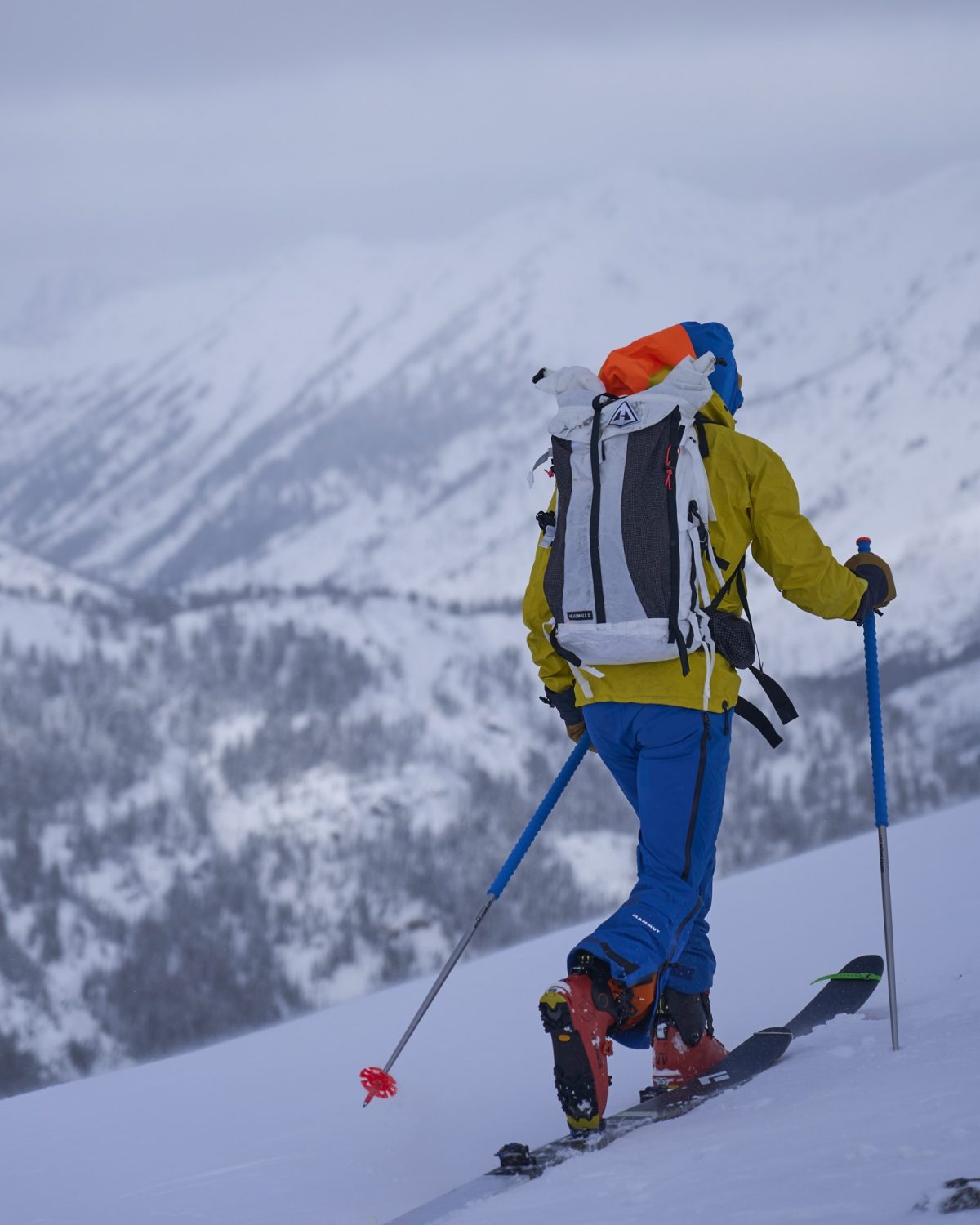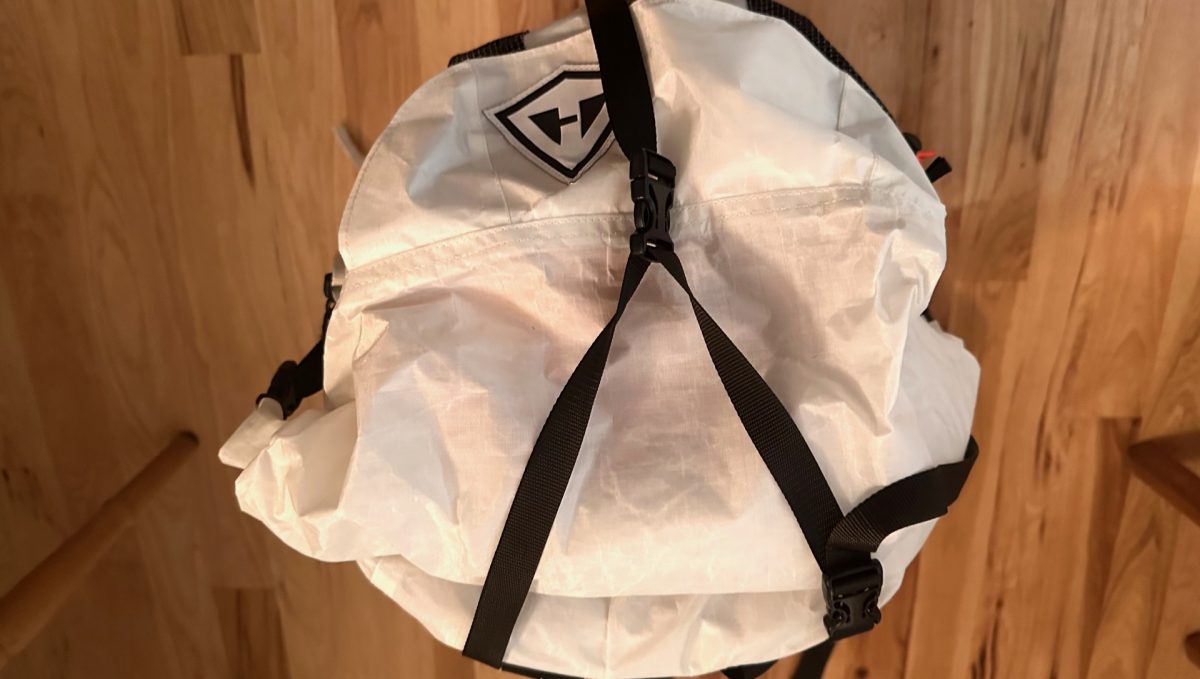
Hyperlite Mountain Gear’s Headwall 55, although quite voluminous for a daypack, and excellent as an overnighter, is a worthy pack with a great feature set.
Now beyond cult-follower status, Hyperlite Mountain Gear (HMG) remains a staple of the backpacking light crowd. Amongst the ski touring community, they have a following too. With the Headwall 55 pack, they introduce their first ski-specific pack that is a great companion for overnighters and single-day tours.
HMG Headwall 55 Specs
Internal Volume: 55 liters
Weight: With all features, 1180g
Ski Carry: Removeable side compression straps.
External safety tool pocket: Closes with a hook/loop closure and/or the over-the-top Y closure.
Axe carry: Dual ice axe loops.
Hipbelt: Removable, with two zippered hip pockets.
Material: Fully Woven Dyneema (High-Abrasion Points and Bottom of Bag), DCH150 Main Body, Dyneema Stretch Mesh Pocket.
Price: $449.00
Light and Plenty of Room
I’ll be honest, when the Hyperlite Mountain Gear Headwall 55 pack was first announced, I was a little disappointed. Fifty-five liters? That’s a ridiculous amount of volume for an everyday ski-touring pack. In my mind, it was a specialized piece reserved for multi-day ski missions. Still, I’m a big fan of Hyperlite’s products, so I was more than willing to test it out and put it through the wringer.
The HMG 2400 Porter is a popular ski pack, and it’s obvious this product line heavily influences the Headwall. In its essence, the Headwall is a 3400 Porter with an external “safety” pocket to store avalanche rescue gear. This may sound boring to some, but why completely redesign an already great product?
The HMG Porters are simple yet functional packs. They feature a single main compartment, a small interior zipper pocket for organization, a roll-top collar suitable for expanding or decreasing volume accordingly, and a minimalist frame consisting of two aluminum stays and an integrated 1/4″ foam pad. The hip belts have two zipper pockets, left and right, for easy access to things like sunglasses, a phone, snacks, and lip balm. And if you use a Porter as a ski pack, like the Headwall 55, the side compression straps A-frame skis securely.
But, the Porter packs are top-access only.

Looking down the main pocket of the Headwall 55 with a big down belay jacket stuffed in the bottoms. Just below the collar, HMG positions their zippered organizer pocket.

The full collar extended on the HMG Headwall 55. The pack, which is ski tour specific, features extra carrying capacity with the collar, which rolls down and secures easily to reduce the over pack volume.
More Headwall 55 Details
There are a few other minor changes compared to the Porter; the sides and bottom of the pack are constructed from Fully Woven Dyneema to add durability against ski edges, and ice axe loops were added.
With the Headwall 55, I’ve got some dissonance going on. I pride myself on taking a minimalistic approach to travel in the backcountry. However, I immediately fell in love with the extra volume the first time I used the Headwall. It’s nice to stuff everything in the pack haphazardly and not worry about volume constraints. An external helmet carry is unnecessary because there’s plenty of volume in the main pack to carry a helmet.
More often than not, I’ll bring a large belay-style parka with me in the backcountry, mostly as a safety item — with the Headwall 55, I’ve got no concerns with a lack of space. I can shove the big puffy in.
Initially, I thought this pack would be excessively big for casual ski tours, but it proved perfect. With the full complement of my mid-winter touring kit, the pack fills to just above the shoulder straps. The extra unused volume is reduced by folding the roll top to compress the excess volume in the pack’s collar.
After deep diving into the specs, the pack’s value to backcountry skiers makes more sense. Comparing the Headwall 55 to the 2400 Porter, the Headwall has the same back width and bottom circumference dimensions. However, the top circumference of the Headwall has 2.5″ more inches of girth (40″ vs. 37.5″). This added circumference may be noticeable climbing steep ice, but this wasn’t what the pack was designed for. Again, the extra girth allows the main pocket to swallow gear, including more high-volume high-loft pieces like warm clothing and possibly carrying some makes of a zero-degree sleeping bag (placed at the pack’s bottom). The height with the collar unrolled is also 4″ taller on the Headwall, but this extra height is unnoticeable with the collar rolled up. For a very small weight penalty, you gain enough volume to pack an overnight kit.
The Safety Tool Pocket
I’m a big fan of dedicated avalanche gear pockets on packs. When seconds are crucial, it’s important to have easy access to your probe and shovel. Also, if your shovel and probe get covered in snow after digging a pit, you don’t have to worry about the rest of your gear getting wet when stored in a dedicated pocket. The avalanche gear pocket on the Headwall is simple yet effective. It has adequate room for essentials, such as a shovel, probe, saw, and ECT cord. Thanks to the Dyneema Stretch Mesh, the safety pocket also has room to store skins which is a nice touch. The Dyneema Stretch Mesh is a relatively new fabric with just enough give while still immensely durable. HMG picked the right tool for the job here.

The Headwall 55’s external safety pocket has plenty of room for the probe, shovel blade/handle, and a set of skins. The black grid pattern fabric is Dyneema Stretch Mesh. The sides of the pack, where the skis are placed for the ski carry, is constructed of durable Fully Woven Dyneema (as is the pack’s bottom). Photo: HMG.
Final Thoughts
One criticism of the pack and HMG, in general, is I wish there were an option to order the pack entirely constructed of Woven Dyneema. This material would be slightly heavier and probably much more expensive, but it would significantly add to the pack’s longevity. The 150 Denier Dyneema, used to construct much of the pack, is reasonably durable but not as durable as Fully Woven Dyneema. Additionally, I know many people yearn for HMG to bring back the fully woven Porter packs, as this was something HMG used to offer.
Check out HMG’s sizing guidelines and ensure that the fit system works for you. The Headwall 55, like most HMG packs, comes in small, medium, large, and tall. For perspective, I know a 6’4″ skier who sizes as a large and a 5’10” skier who is a solid medium. The large works for me at roughly 6′.
Weight-wise, the Headwall comes in at 1,180 grams. Comparatively, the Porter 2400 weighs 859g and the Porter 3400 936g. While this increase in weight isn’t insignificant, it’s a small price to pay for the added safety and convenience of a dedicated avalanche gear pocket and the additional volume the Headwall offers. For fast and light missions in the spring with a locked-up snowpack, the Porter 2400 may be the ideal tool for the job, but for everything else, I’ll be reaching for the Headwall 55.
Austin Mallet is originally from the flatlands of Houston, TX. Once the career opportunity presented itself, he moved to Bozeman, MT and never looked back. It didn’t take long to fall in love with the mountains and all the activities they have to offer. While living in Texas, Austin raced road bikes so it was an easy transition into the spandex clad world of skimo racing. These days, Austin is most passionate about climbing (specifically in the alpine) and ski mountaineering with a little trail running mixed in for good measure.

